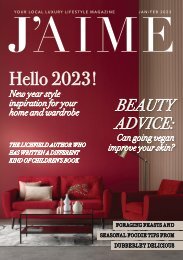Create successful ePaper yourself
Turn your PDF publications into a flip-book with our unique Google optimized e-Paper software.
H E A LT H
Banish the ‘mum tum’
SPORTING A ‘MUMMY TUMMY’? GOT WHAT LOOKS LIKE A ‘HANGING POUCH’? THIS
MONTH, LICHFIELD’S SMILIEST PERSONAL TRAINER RAÚL ROMERO TALKS POSTPARTUM
FITNESS AND HOW SPECIFIC EXERCISES CAN HELP YOU LOSE THE ‘MUM TUM’
WITH TIME PRECIOUS,
SHORT, EFFECTIVE
EXERCISES CAN HAVE A
LONGLASTING EFFECT ON
POSTPARTUM HEALTH
This month, I would like to address a topic that
affects the majority of women after giving birth in
many different ways (and that I am also living first
hand at home after my wife gave birth a year ago!)
which is; the ‘mum tum’.
Yes, it is a symbol of the incredible strength and
courage that women show when giving birth and I
strongly believe that women should be immensely
proud of the changes to their bodies after bringing
a life into the world. Yet I have had countless female
clients who disfavour (to put it lightly!) the ‘mum
tum’ and would like to forever banish it from their
bodies.
To all these women, I’d like to say that contrary to
popular belief, the ‘mum tum’ is not only a cosmetic
issue, but is an actual real life medical condition
called ‘diastasis recti’ or ‘divarication’. Hopefully
in understanding how and why it appears, we can
be better informed in how to exercise it to help the
affected women feel great about their bodies.
During pregnancy, it is common for the two muscles
that run down the middle of your stomach - the
abdominals - to separate and stretch sideways,
therefore the connective tissue running down the
midline of the torso, called the linea alba, can
become overstretched and weak. This weakness is
what compromises the back and core, otherwise
known as ‘diastasis recti’. It is also linked to
pelvic floor health, can cause digestion issues and
contributes to urinary and stress incontinence.
This separation between the stomach muscles
should usually go back to ‘normal’ by eight weeks
postpartum; however for more than 30% of women,
this is usually longer. This is why abdominal exercises
50

















